by Bhanu Chopra
During my visit to the Tutima booth at Baselworld 2019, I arranged a tour of the brand’s manufacturing facilities in Glashütte for later in the year to see the in-house production first-hand along with the entire Grand Flieger collection.
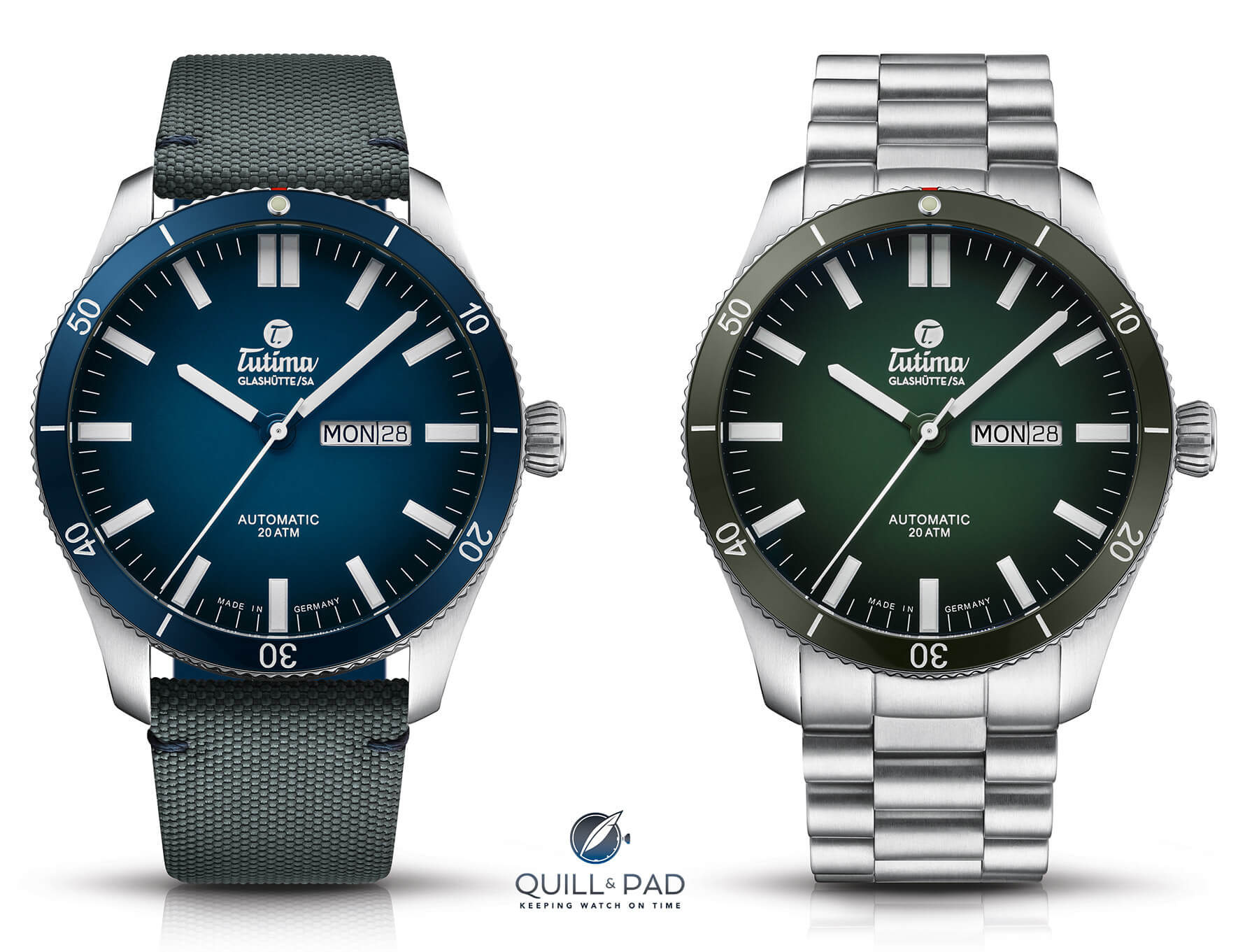
Tutima Glashütte Grand Flieger Airport models with blue and green dials
And in December 2019 Tutima welcomed me to its modern manufacture just a stone’s throw from the Nomos manufacture, the Glashütte Original factory, and A. Lange & Söhne’s historical headquarters.

Tutima headquarters and factory in Glashütte
Brief history of Tutima
Following World War I, a severe economic crisis gripped the Glashütte region. In 1927, a young attorney by the name of Dr. Ernst Kurtz was recruited by a Saxon bank to manage the crisis in Glashütte.
Kurtz established two companies, Uhren-Rohwerke-Fabrik Glashütte AG (UROFA) and Uhrenfabrik Glashütte AG (UFAG). UROFA-UFAG produced ebauches and pocket watches at first, and wristwatches later, which until then had been a rarity in Glashütte, to better compete with the Swiss watch industry’s takeover of the burgeoning wristwatch market.
In 1939/1940, under the management of Kurtz, the first German two-pusher flyback chronograph was manufactured (Caliber 59), now known as the original Tutima Glashütte pilot’s chronograph. This chronograph emerged under the UROFA-UFAG brand name “Tutima,” which derives from the Latin word tutus (“safe,” “protected”).
After the war ended, Kurtz continued to produce watches in the Bavarian town Memmelsdorf with the help of former employees from Glashütte after fleeing what had become the Russian zone (that became East Germany).
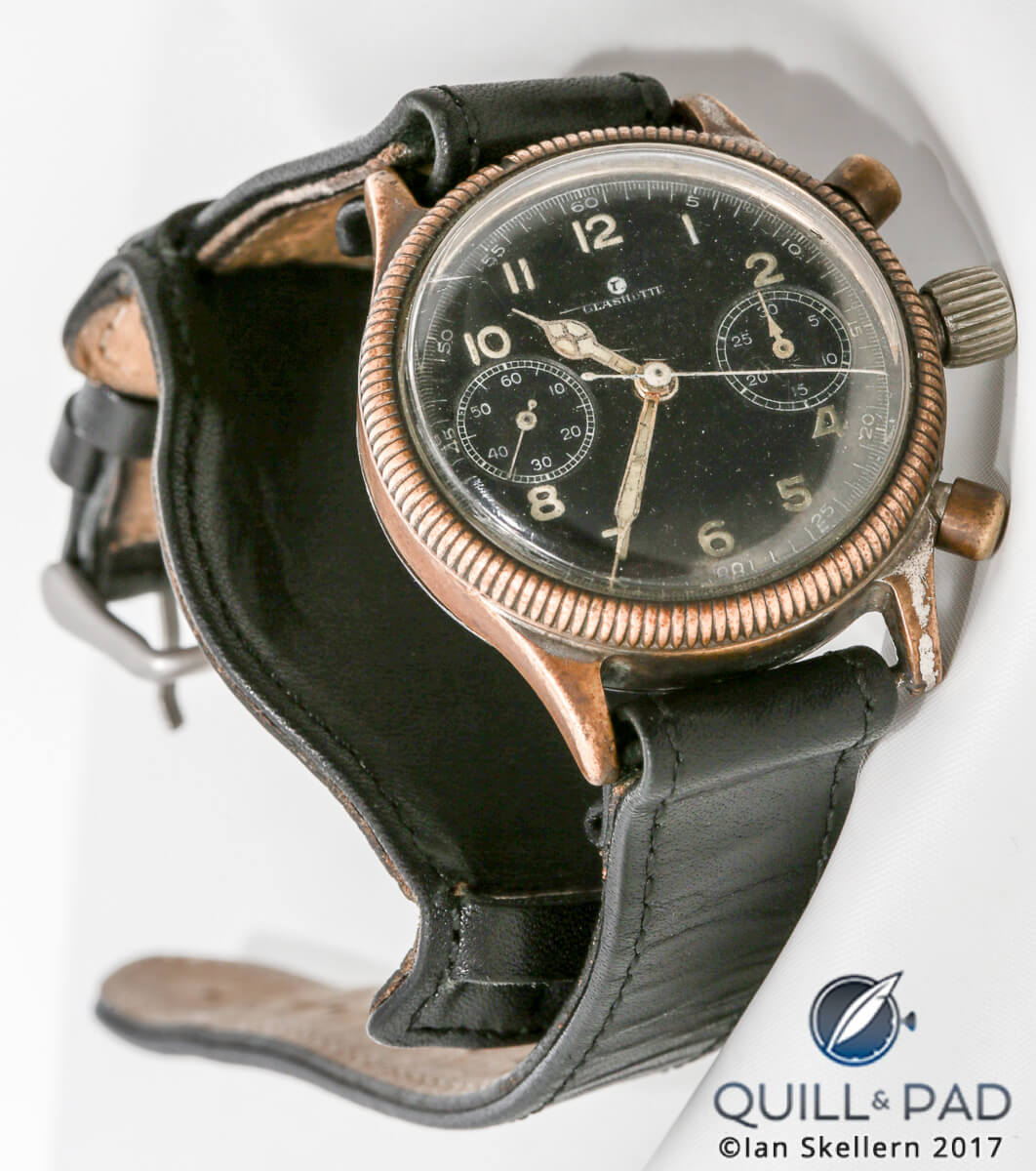
Original 1940s Tutima pilot’s chronograph with Caliber 59 movement
In 1951 Kurtz transferred production to Ganderkesee, high in Germany’s north, and by 1960 Dieter Delecate had gone on to write the next chapter of Tutima’s story, one of rebuilding and reconfiguring. Fighting one of the next dark cycles in horological history – inexpensive quartz from the east – he eventually established Tutima Uhrenfabrik GmbH and produced chronographs for military institutions, carrying on the company’s long tradition.
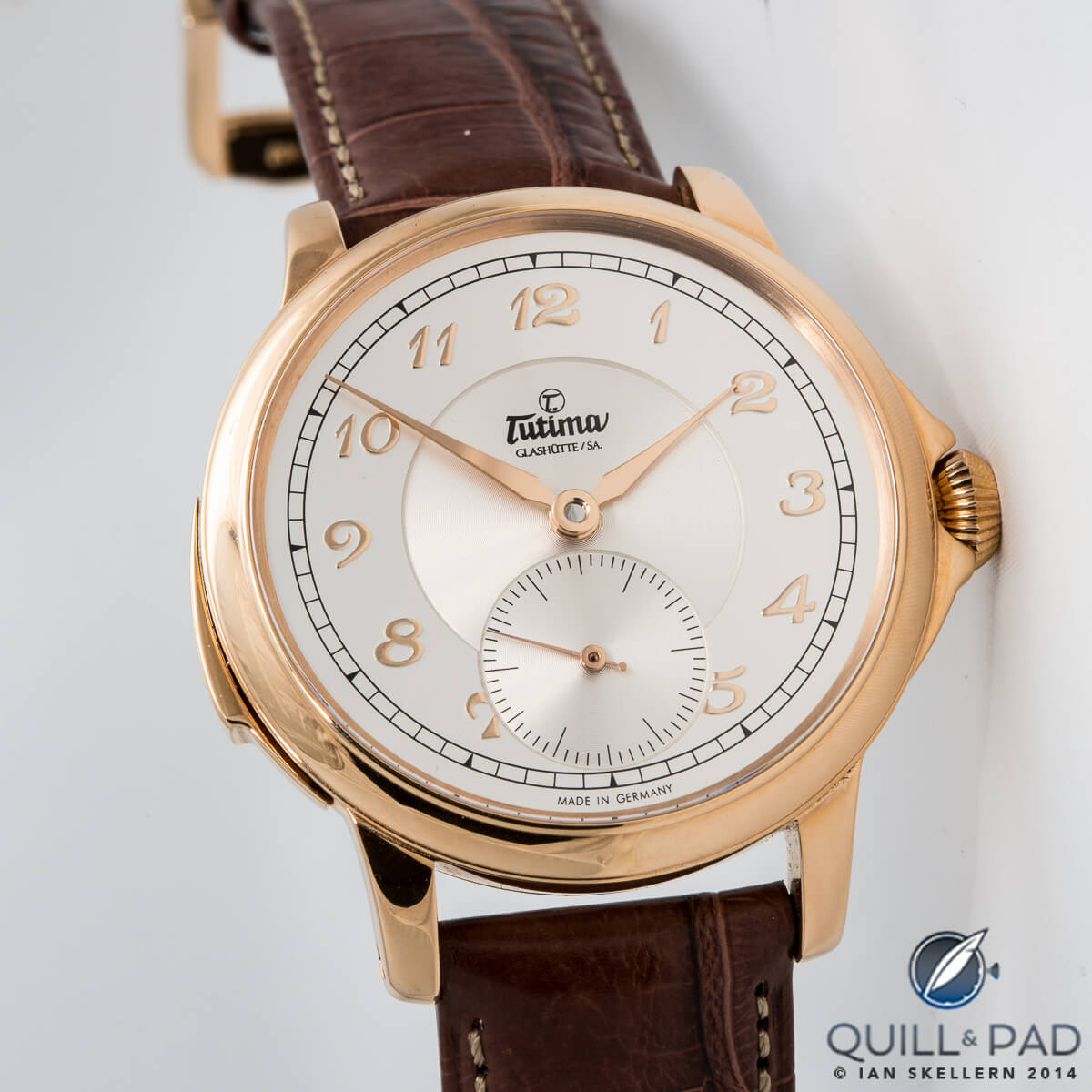
Tutima Hommage Minute Repeater in red gold with classic dial
In 2011, Tutima celebrated having relocated part of its operations back to its original home – Glashütte – and beginning an exciting new chapter in high horology with the very first minute repeater made on German soil.
For a more complete chronicle, see Elizabeth Doerr’s 90 Years Of Tutima: An Abbreviated, Complete History.
Impressions of Tutima
My first observation upon visiting is that while Tutima has an impressive modern factory nestled between large watch companies, it is very much a family-run operation.
Tutima is 100 percent family owned and operated. It is also apparent that this is not the same watch brand of the 1980s, 1990s, and early 2000s.
During that period, Tutima was synonymous with sub-$3,000 military-styled tool chronographs. Now it also manufactures in-house movements in precious-metal cases. But there is good justification behind the higher price points associated with developing in-house movements and raising the level of watchmaking.
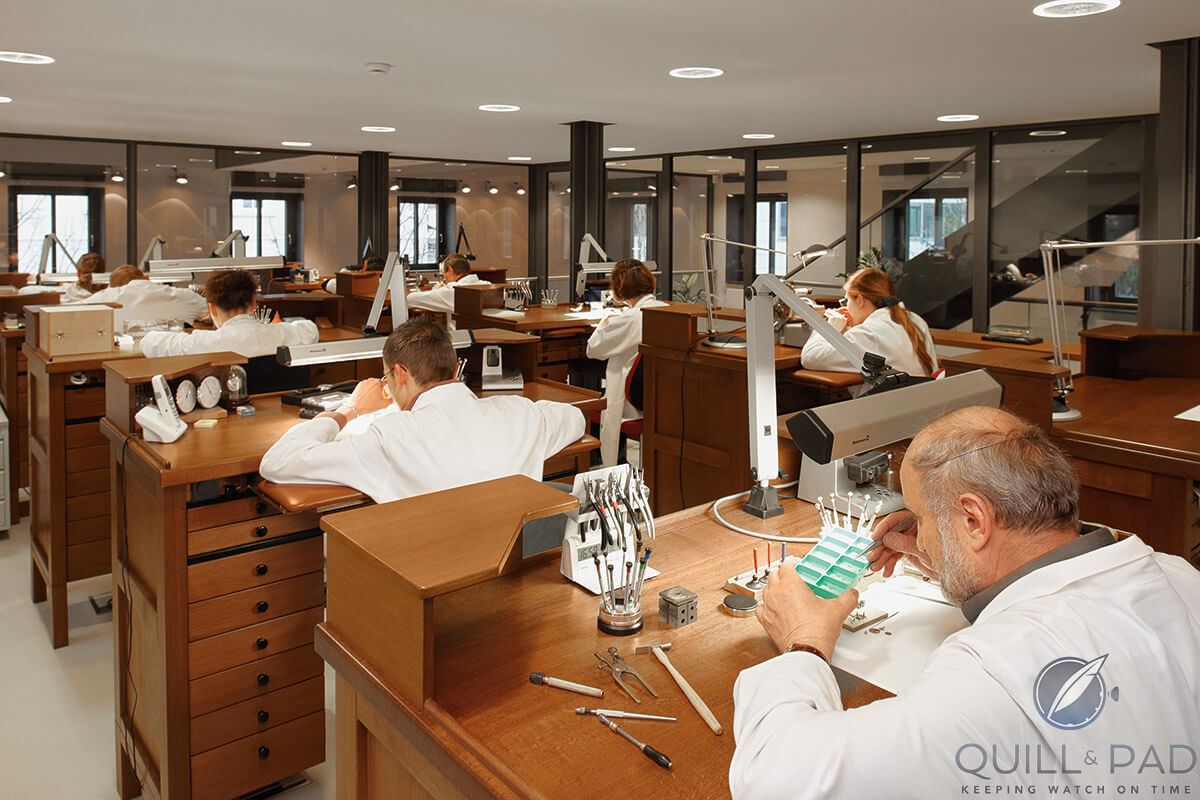
Inside Tutima’s Glashütte factory
For a company to use the “Made in Glashütte” predicate, it must create 50 percent of the value of the watch in Glashütte. Tutima has done well with the use of in-house movements, reaching far more than the specified 50 percent, especially in its Patria line.
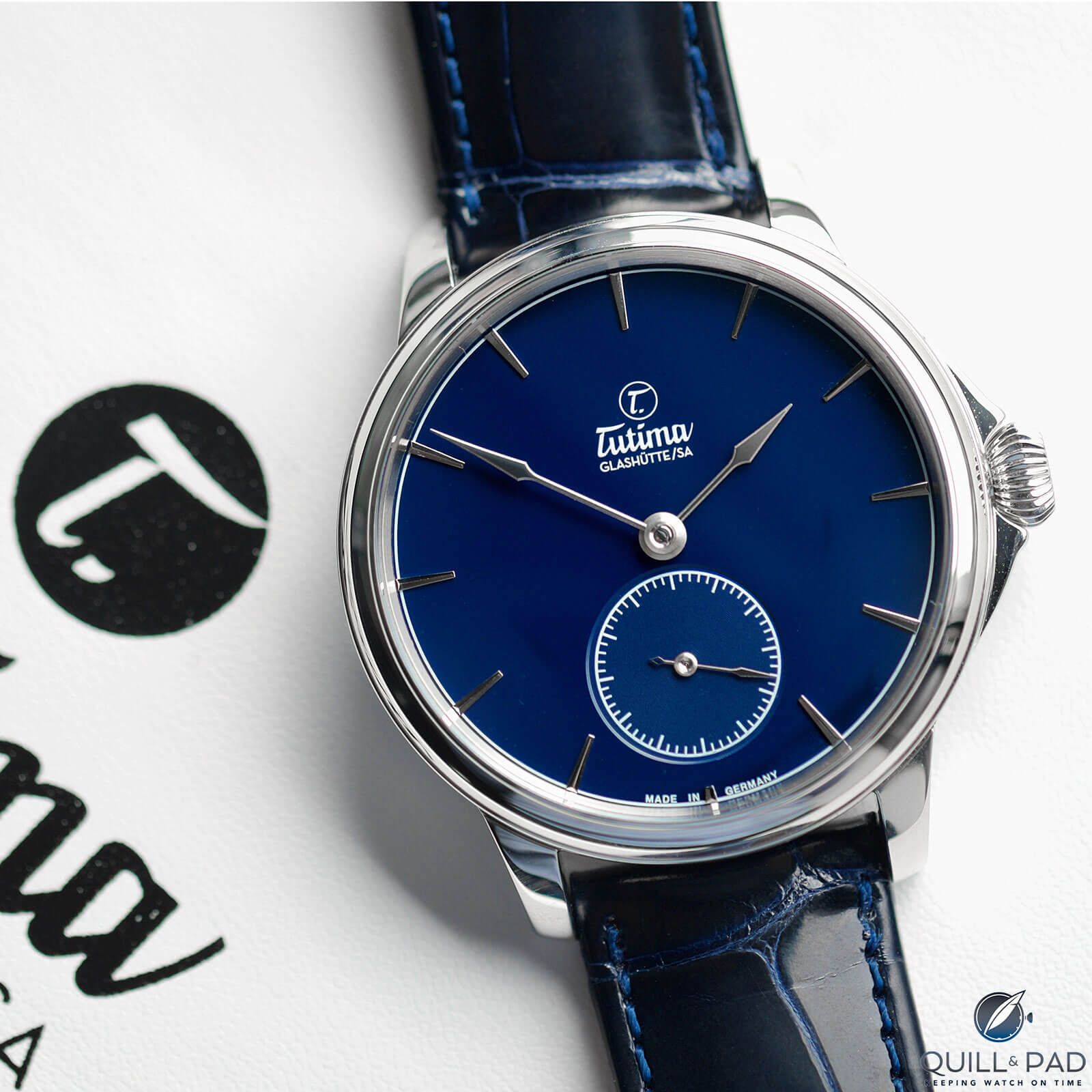
Tutima Patria Admiral Blue
The Patria Admiral Blue, priced at $5,900, exhibits hand-finishing similar to a higher priced watch by other companies in Glashütte. I predict that current pricing may not be sustainable in the long run and prices are likely increase.
While Tutima has one leg in the realm of fine watchmaking, the other leg is firmly placed in its lower to mid-priced Flieger collection, comprising German pilot-style watches made in a second, smaller workshop in Glashütte.
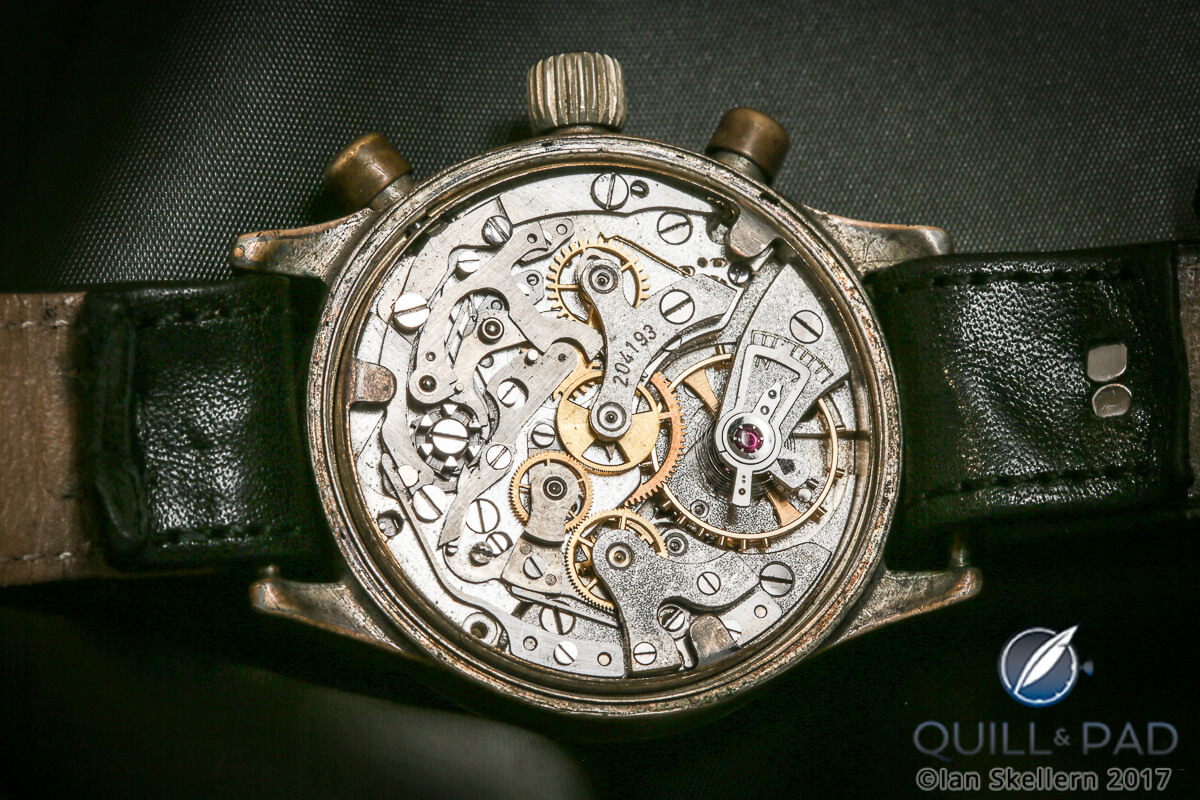
Vintage Urofa Caliber 59 in a 1940s Tutima pilot’s flyback chronograph
Tutima was responsible for the legendary UROFA 59 flyback movement and NATO’s Lémania-based instrument chronographs of the 1990s.
Therefore, the Tutima M2 series includes several variations inspired by these quasi-legendary NATO watches, while the Grand Flieger line includes more traditional pilot-style watches inspired by the 1940s military-issue watches.
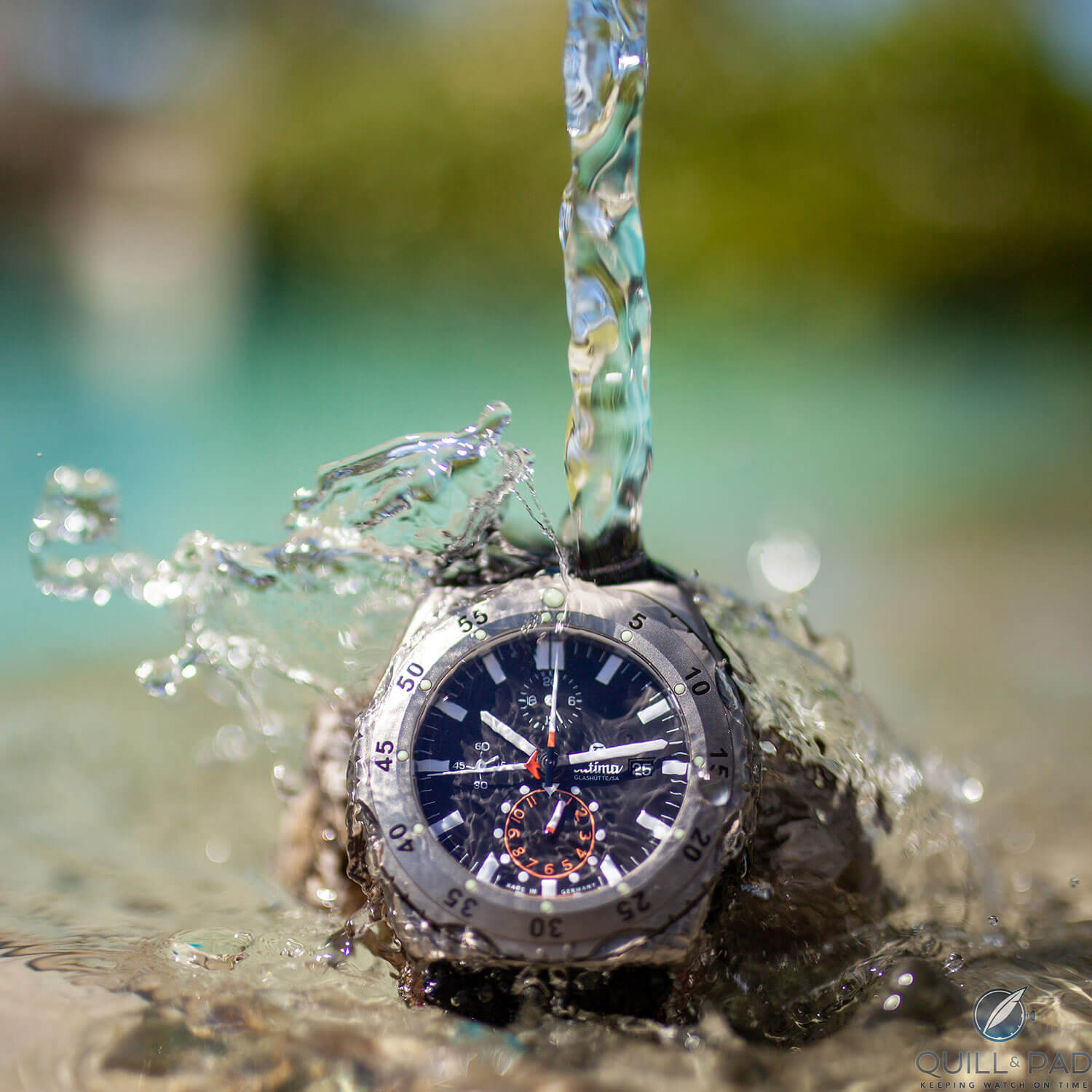
Tutima M2 Pioneer (photo courtesy Sadry Ghacir)
Tutima M2 lines
So what is different in the M2 series of yesterday and today?
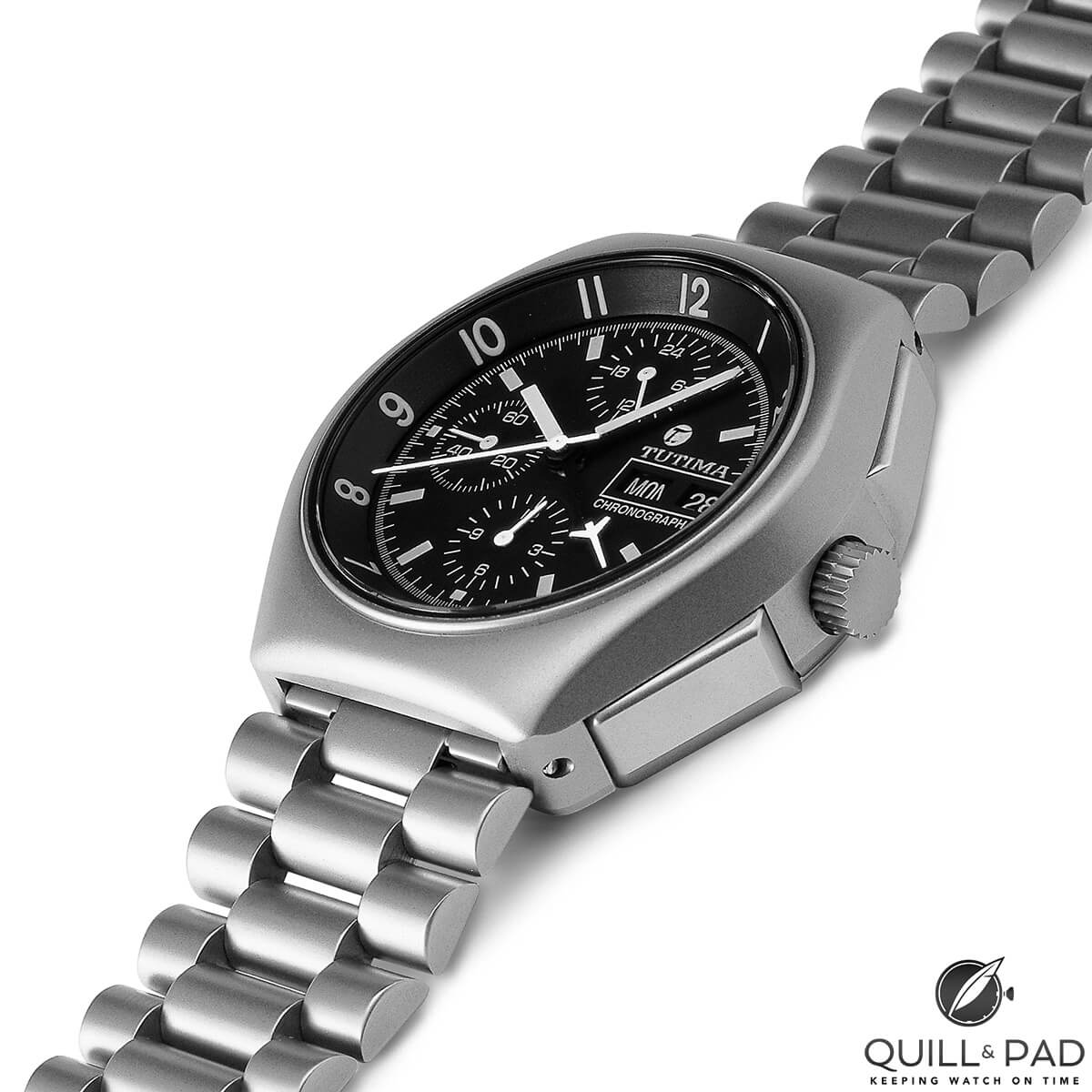
A vintage Tutima Reference 798-02 Military Chronograph
It comes down to movement, size, features, and price. The overall appearance is quite the same, however, they have been supersized.
The modern M2 series starts at 43 mm and goes up to 46 mm. The 43 mm in titanium with no bezel is easy to pull off on a 6.5-inch wrist.
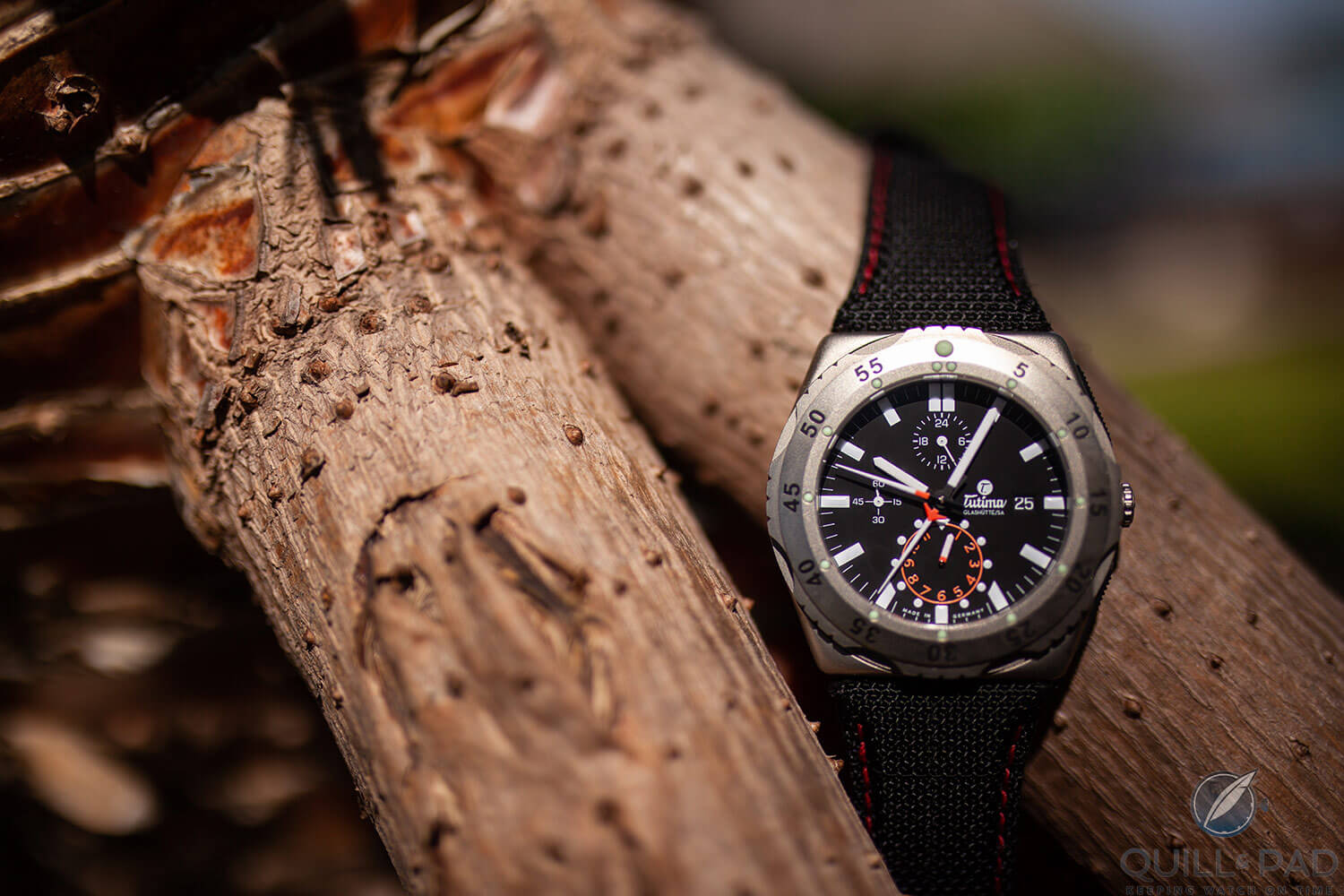
Tutima M2 Pioneer (photo courtesy Sadry Ghacir)
The Lémania 5100, which Tutima began using in these models in 1984, is a movement that helped set these watches apart from others of their genre, however it is no longer in production after Lémania was integrated into the Swatch group (the former Lémania factory is now Breguet’s manufacture). So now Tutima uses heavily modified Valjoux 7750 movements for the M2 chronographs, which Tutima calls Caliber 521, and ETA movements for the three-hand Flieger models.
The massive titanium case has a silver brushed color using a process that Tutima calls pearl-blasted titanium. What was previously a traditional soft-iron inner cage for protection against magnetic fields has been replaced by a coating of mu-metal, a nickel-iron alloy, a good, modern solution.
The flat, integrated pushers on current M2 models are very similar to the original and constitute one of my favorite features of this watch.
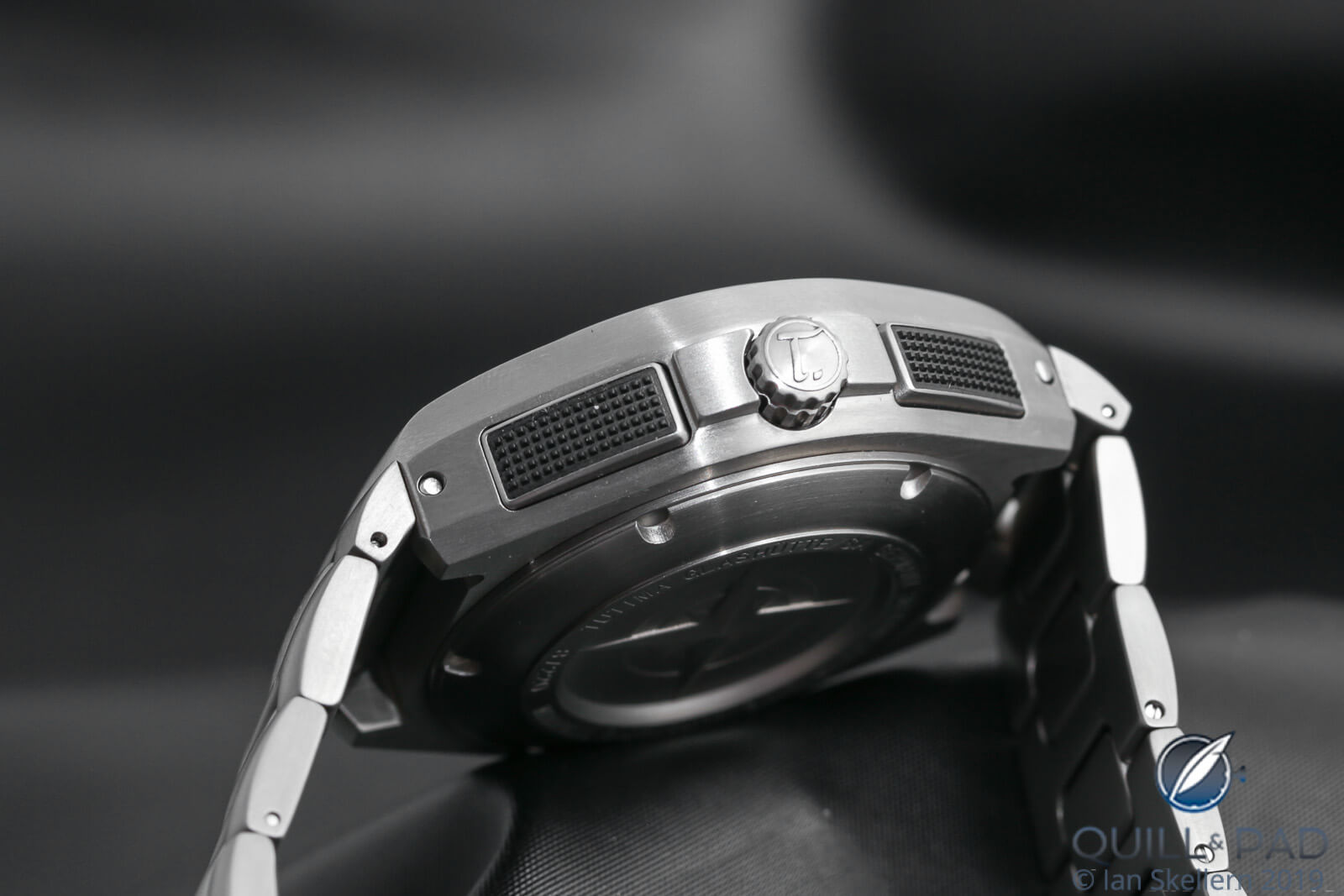
Tutima M2 chronograph pushers
Due to higher manufacturing costs, the prices have doubled compared to the previous M2 series. To fill the gap at the lower end, Tutima has added entry-level M2 Seven Seas and Coastline series; a three-hand M2 Coastline is priced under $2,000.
Tutima Grand Fliegers
The Grand Flieger series, which began life in 1994 as a reproduction of the original pilot’s chronograph of 1940, takes its most obvious design cues from these early watches with its cathedral hands and coin-edge rotating bezel with red reference mark.
However, the Grand Flieger now has a much larger 43 mm case. It is still outfitted with a modified Valjoux 7750 automatic movement, screw-down crown, and a domed sapphire crystal with anti-reflective treatment on both sides.
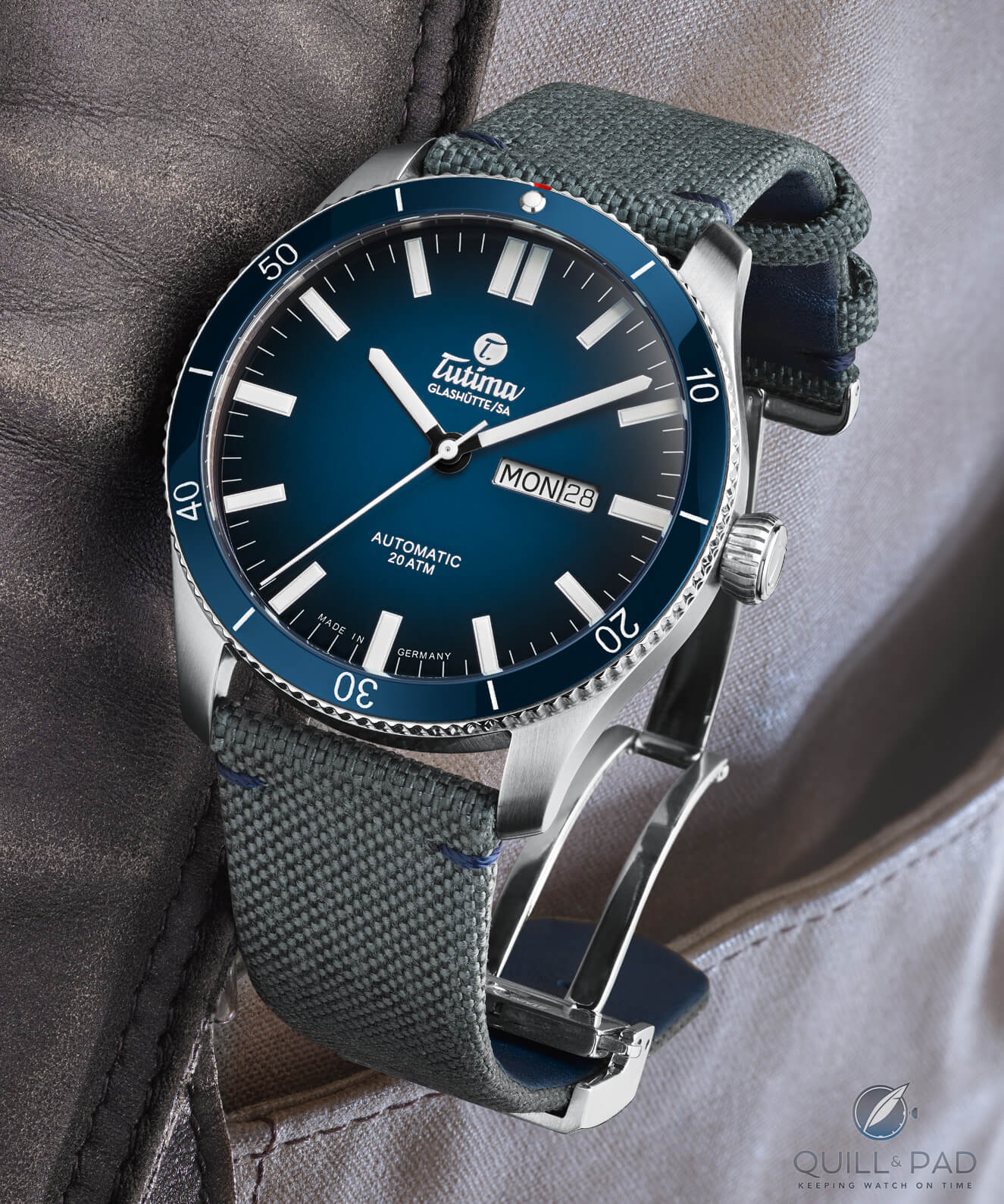
Tutima Glashütte Grand Flieger Airport with blue dial
The Grand Flieger Airport series is a more modern interpretation available in contemporary color combinations with a smooth rotating ceramic bezel offering 10-minute divisions and the requisite red reference mark at 12 o’clock.
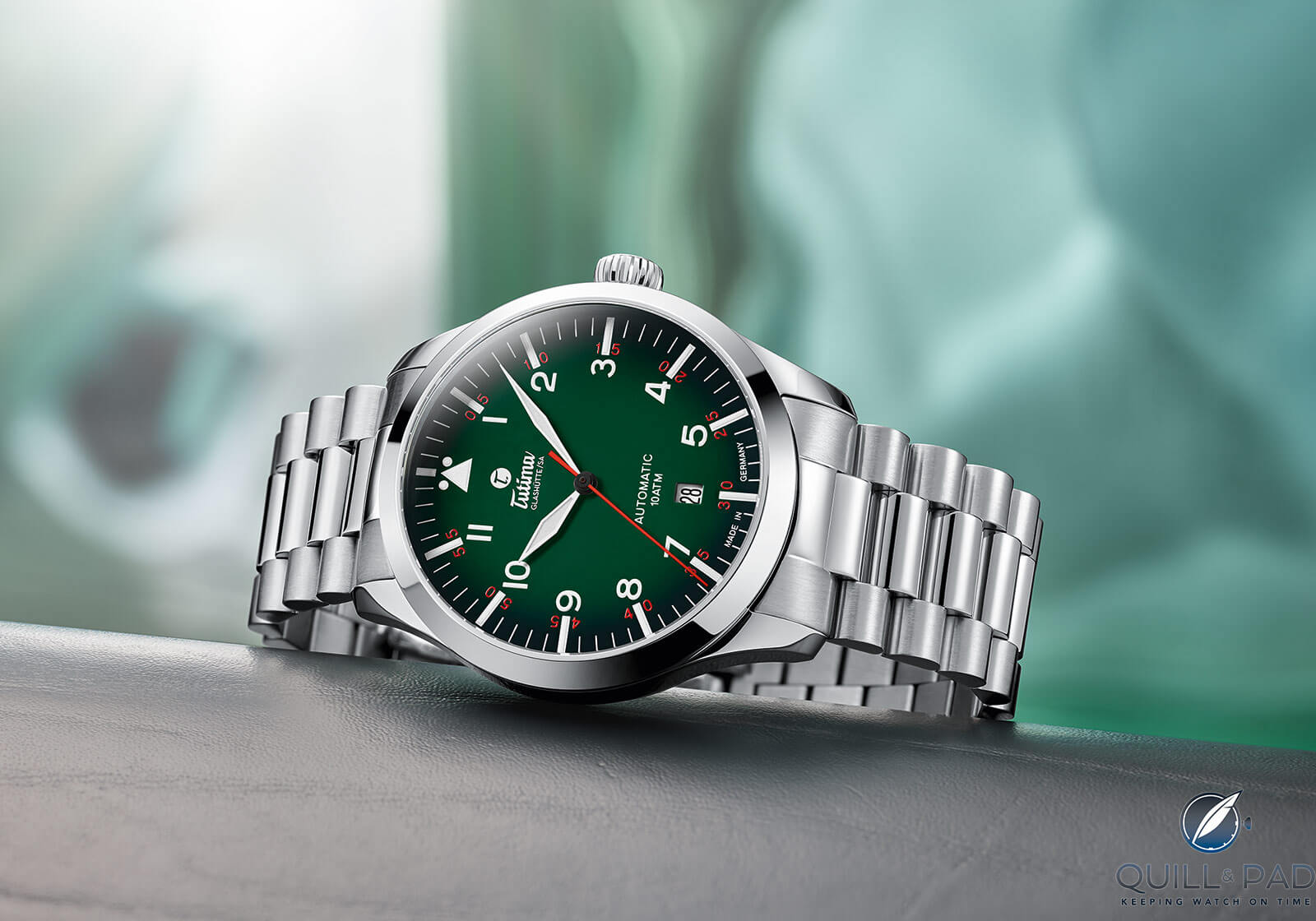
Tutima Grand Flieger Automatic with green dial and metal bracelet
Finally, we come to the entry-level Grand Flieger Classic Automatic series with colorful brown, black, grey, olive, and – my favorite – green dials. All timepieces in the Grand Flieger lineup are water-resistant to 20 atm, have a screw-in crown, and rotor decorated with gold Tutima seal.
Tutima has made tremendous progress in the short period since returning to Glashütte, expanding beyond mid-priced pilot’s watches with elegant traditionally styled timepieces featuring in-house movements.
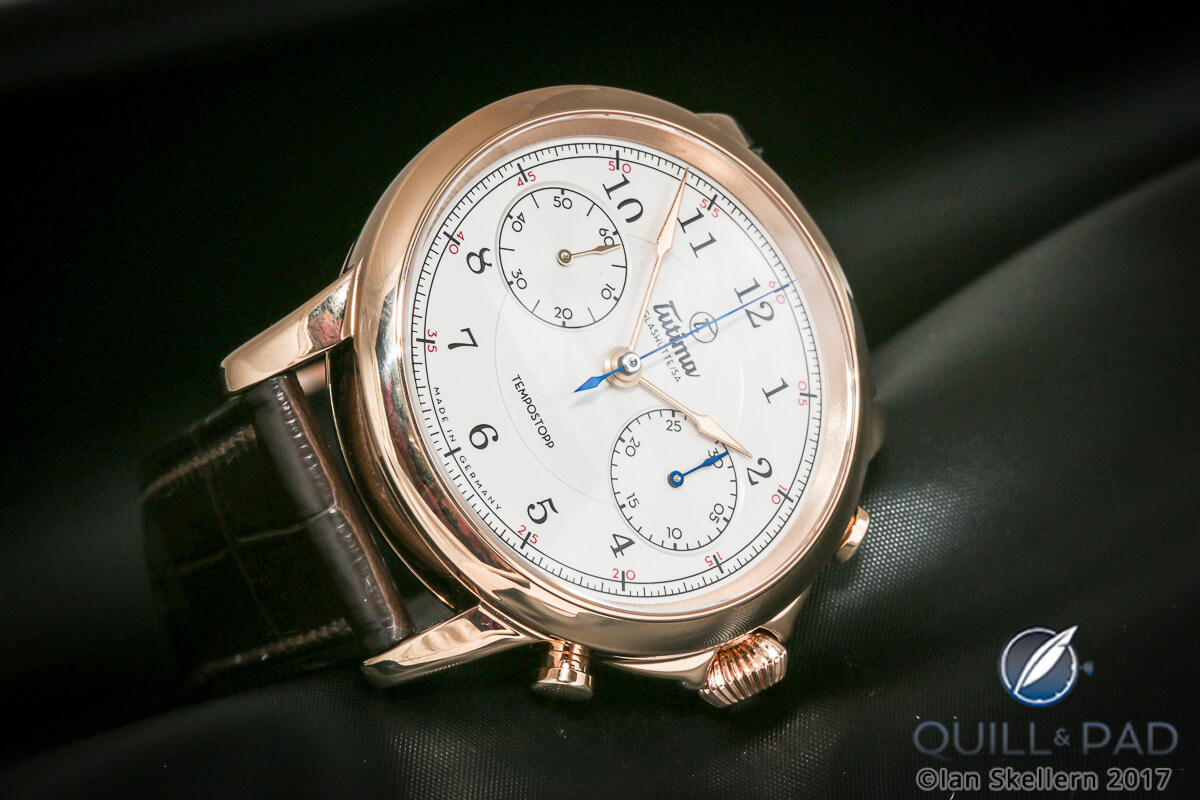
Tutima Tempostopp flyback chronograph
In my biased opinion, Tutima’s success will be defined both by fine watchmaking and the re-introduction of its innovative flyback chronograph Caliber 659 (a re-engineer of the old UROFA 59 movement) in another pilot’s watch: the Tempostopp.
As I left Glashütte and drove back to Dresden, looking forward to experiencing the excitement of the city’s traditional Christmas market before going home, I reflected that while time seems to pass slowly in Glashütte, it never stands still or is forgotten. And Tutima exemplifies this well.
For more information, please visit www.tutima.com.
Quick Facts Tutima Patria Admiral Blue
Case: 43 x 9.7 mm, stainless steel
Movement: manually wound manufacture Caliber 617 with screw balance, 3 Hz/21,600 vph frequency, power reserve 65 hours, Glashütte three-quarter plate
Functions: hours, minutes, small seconds
Price: €4,900/$5,900
* This article was first published on June 26, 2020 at You Are There: Visiting Tutima Glashütte In Germany.
You may also enjoy:
Tutima Patria Admiral: Blue Blazes For Every Day
‘Made In Glashütte’ Vs. ‘Made In Germany’: What Puts Them Together, What Sets Them Apart
90 Years Of Tutima: An Abbreviated, Complete History§12
Tutima Saxon One Lady: Edgy Elegance With A Cushion-Shaped Twist
Leave a Reply
Want to join the discussion?Feel free to contribute!





















































Great review, Bhanu! I am a huge fan of Tutima. Although my only Tutima is the ‘Flieger Friday’ I have had my eyes on the brand for years. We are fortunate to have an AD here in Vancouver, so I can drop by and admire some of the models from time-to-time. They have had a couple of the lovely Patrimoni over the past couple of years. And, yes, your prediction was correct: the price has recently gone up considerably. Nevertheless, even with the increase, the model still represents incredible value. The Tutima Grand Flieger models are incredible value. I could go on and on. Thanks for the review!